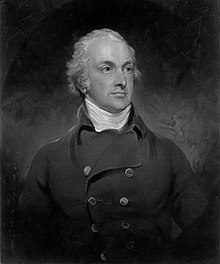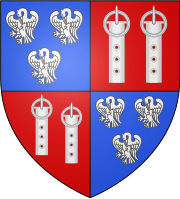Thomas Pelham, 2nd Earl of Chichester
Thomas Pelham, 2nd Earl of Chichester , PC , FRS (born April 28, 1756 in Spring Gardens, St James's, City of Westminster , London , † July 4, 1826 in Stratton Street, Mayfair , City of Westminster, London) was a British statesman , among other things, from 1780 to 1801 deputy of the lower house ( House of Commons ) was. He repeatedly held the post of Chief Secretary for Ireland ( Chief Secretary for Ireland ) and took over the course of a Writ of Acceleration in 1801 by his father Thomas Pelham, 1st Earl of Chichester early title of the 3rd Baron Pelham and became a member of the Upper House ( House of Lords ) . He was from 1801 to 1803 Minister of the Interior (Home Secretary) and then from 1803 to 1804 Chancellor of the Duchy of Lancaster ( Chancellor of the Duchy of Lancaster ) . After the death of his father, he finally became 2nd Earl of Chichester in 1805 . Most recently he was postmaster general from 1807 until his death in 1826 .
Life
Family background, Member of the House of Commons and Chief Secretary for Ireland
Thomas Pelham was the eldest son of six children of the House of Commons Thomas Pelham , who was raised to Earl of Chichester in 1801, and his wife Anne Frankland. He was in on 26 May 1756 Anglican church St Martin-in-the-Fields baptized . His sister Henrietta Anne Pelham was married to George Evelyn-Leslie, 13th Earl of Rothes . In turn, his sister Frances Pelham was the wife of George Brodrick, 4th Viscount Midleton , while his younger brother Henry Pelham was married to Catherine Cobbe, a daughter of House of Commons Thomas Cobbe . His younger brother, George Pelham, was an Anglican clergyman and Bishop of Bristol , Bishop of Exeter and most recently Bishop of Lincoln . His youngest sister Lucy Pelham was married to the House of Commons John Baker Holroyd , who in 1816 was 1st Earl of Sheffield in the Peerage of Ireland .
After attending the renowned Westminster School, which was re-established in 1560, Thomas Pelham began studying at Clare College at the University of Cambridge , which he completed in 1775 with a Master of Arts (MA). In 1780 he became a deputy of the lower house ( House of Commons ) of the British Parliament (Parliament of Great Britain) and represented there until 1801 the constituency Sussex . Between 1782 and 1783 he was the general surveyor of the artillery (Surveyor-General of the Ordnance) and as such representative of the General Master of the Artillery (Master-General of the Ordnance) . In 1783 he was also a member of the lower house (Irish House of Commons) of the Parliament of Ireland ( Parliament of Ireland ) and represented there first to 1790 the constituency of Carrick-on-Shannon . As the successor to William Windham he became in 1783 the first Chief Secretary for Ireland ( Chief Secretary for Ireland ) and was until his replacement by Thomas Orde 1784 after the Lord Lieutenant of Ireland 's second highest British representative. In this capacity he became a member of the Irish Privy Council of Ireland on September 13, 1783 .
Secretary of State for Ireland, Member of the House of Lords and Minister
1795 Pelham was again a member of the Irish House of Commons and now represented the constituency of Clogher until 1797 . As the successor to George Damer, Viscount Milton from 1795 until his replacement by Robert Stewart, Viscount Castlereagh in 1798, he was once again Chief Secretary for Ireland. As such, he was on 11 March 1795 also a member of the Secret Privy Council ( Privy Council ) of the Kingdom of Great Britain . He was also the successor to Edmund Henry Pery, 2nd Baron Glentworth from 1796 until his replacement by Robert Stewart, Viscount Castlereagh in 1797, and Secretary of State for Ireland . He was still a member of the Irish House of Commons from 1797 to 1799 , where he now represented the constituency of Armagh . On April 24, 1800 he became a Fellow of the Royal Society (FRS). He was briefly a member of the lower house of the United Kingdom of Great Britain and Ireland , which was formed on January 1, 1801 .
As part of a Writ of Acceleration Thomas Pelham took over on 23 June 1801 by his father Thomas Pelham, 1st Earl of Chichester early title of the 3rd Baron Pelham , of Stanmer, in the County Sussex, and became a member of the Upper House ( House of Lords ) , to which he belonged until his death. After he briefly a member of the Audit of British India (Commissioner of the Board of Control for India) was, he was on 30 July 1801. Cabinet Addington succeeded Lord William Bentinck, 3rd Duke of Portland as Minister of the Interior (Home Secretary) . He held this ministerial office until August 17, 1803 and was then replaced by Charles Philip Yorke . In addition, he was as the successor to Robert Hobart, Lord Hobart from 1801 until his replacement by Robert Jenkins, Viscount Hawkesbury 1803 also Leader of the House of Lords (Leader of the House of Lords) . He then broke in 1803 Charles Jenkinson, 1st Earl of Liverpool as Chancellor of the Duchy of Lancaster ( Chancellor of the Duchy of Lancaster ) , and had held that post until 1804, after which Henry Phipps, 1st Baron Mulgrave became his successor. As the successor to Heneage Finch, 4th Earl of Aylesford , he was also Captain of the Yeomen of the Guard in 1804 , but passed this function on to George Parker, 4th Earl of Macclesfield a short time later .
On the death of his father, Thomas Pelham, 3rd Baron Pelham, became 2nd Earl of Chichester on January 8, 1805 . In addition, he inherited the associated title of 7th Baronet , of Laughton in the County of Sussex, which was created in 1611 in the Baronetage of England . Most recently he was Postmaster General from 1807 until his death in 1826 , where he held this post from 1807 to 1814 with John Montagu, 5th Earl of Sandwich , from 1814 to 1816 with Richard Trench, 2nd Earl of Clancarty and from Dressed together with James Cecil, 1st Marquess of Salisbury from 1816 to 1823 . He was also President of the Royal Institution of Great Britain between 1825 and 1826 .
Marriage and offspring

Thomas Pelham, 3rd Baron Pelham, married Mary Henrietta Juliana Osborne , daughter of Francis Osborne, 5th Duke of Leeds , who was foreign minister between 1783 and 1791 , and his wife Lady Amelia on July 16, 1801 in Lambeth Palace, London Darcy.
From this marriage three sons and three daughters were born. The eldest son Henry Thomas Pelham inherited when Thomas Pelham died on July 4, 1826, his title of nobility as 3rd Earl of Chichester. The eldest daughter, Lady Amelia Rose Pelham, was married to Major General Sir Joshua Jebb . The second eldest son, Frederick Thomas Pelham, was Rear Admiral in the Royal Navy and lastly Second Sea Lord between 1859 and his death in 1861 . The third son, John Thomas Pelham, was a clergyman in the Church of England and Bishop of Norwich from 1857 to 1893 . The second eldest daughter, Lady Catherine Georgiana Pelham, was the wife of the clergyman Reverend Lowther John Barrington, son of George Barrington, 5th Viscount Barrington . The youngest daughter, Lady Lucy Anne Pelham, was the wife of the politician David Barnett Dundas , who was also a member of the lower house.
Web links
- Mr Thomas Pelham at Hansard (English)
- Chichester, Earl of (UK, 1801) in Cracroft's Peerage
- Thomas Pelham, 2nd Earl of Chichester on thepeerage.com , accessed June 14, 2020.
Individual evidence
| predecessor | Office | successor |
|---|---|---|
| Thomas Pelham |
Baron Pelham (by Writ of Acceleration) 1801-1826 |
Henry Pelham |
| Thomas Pelham |
Earl of Chichester 1805-1826 |
Henry Pelham |
| personal data | |
|---|---|
| SURNAME | Pelham, Thomas, 2nd Earl of Chichester |
| ALTERNATIVE NAMES | Pelham, Thomas, 3rd Baron Pelham |
| BRIEF DESCRIPTION | British politician, MP and peer |
| DATE OF BIRTH | April 28, 1756 |
| PLACE OF BIRTH | Spring Gardens, St James's, City of Westminster , London |
| DATE OF DEATH | April 4, 1826 |
| Place of death | Stratton Street, Mayfair , City of Westminster , London |


